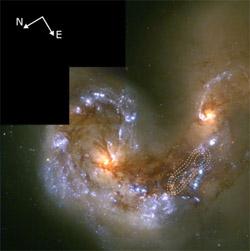Missing Link between Galaxy Collisions and Star Birth Is Found (Photo)
(Clearwisdom.net) Data from ISO, the infrared observatory of the European Space Agency (ESA), have provided the first direct evidence that shock waves generated by galaxy collisions excite the gas from which new stars will form. The result also provides important clues on how the birth of the first stars was triggered and speeded up in the early Universe.
By observing our galaxy and others, scientists have long concluded that the explosion of massive stars like supernovae generates shock waves and 'winds' that travel through and excite the surrounding gas clouds. This process triggers the collapse of nearby gas that eventually leads to the birth of new stars, like a domino effect.
The signature of this process is the radiation emitted by molecular hydrogen. When hydrogen molecules are 'excited' by the energy of a nearby explosion, they emit a distinctive type of radiation that can be detected in the infrared.
This type of radiation is also observed in places where galaxies have collided with one another and the formation of new stars goes at a very high rate. So far, however, there was no clear picture of what happens in the time between the collision of two galaxies and the birth of the first new stars.
The missing link has now been found by a team of German astronomers that have analyzed ISO data of the galaxy pair nicknamed the 'Antennae' (NGC 4038/4039). These two galaxies, located 60 million light-years away in the constellation 'Corvus' (the Crow), are currently at an early stage of encounter. The scientists noticed that the overlapping region of the two colliding galaxies is very rich in molecular hydrogen, which is in an excited state.
The astronomers believe that star formation induced by shocks may have played a role in the evolution of proto-galaxies in the first thousand million years of the life of our Universe. Shock waves produced through the collision of proto-galaxies may have triggered the condensation process and speeded-up the birth of the very first stars. Unfortunately, what causes galaxies to collide and why new stars form might forever remain a mystery to astronomers.
References:
http://www.universetoday.com/am/publish/galaxy_collisions_lead_starbirth.html?2932005
http://www.spacedaily.com/news/stellar-chemistry-05m.html
